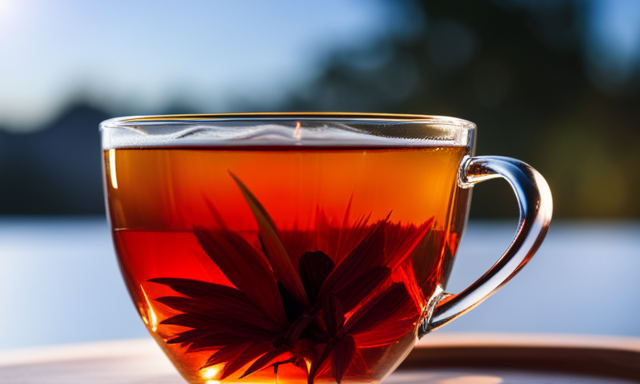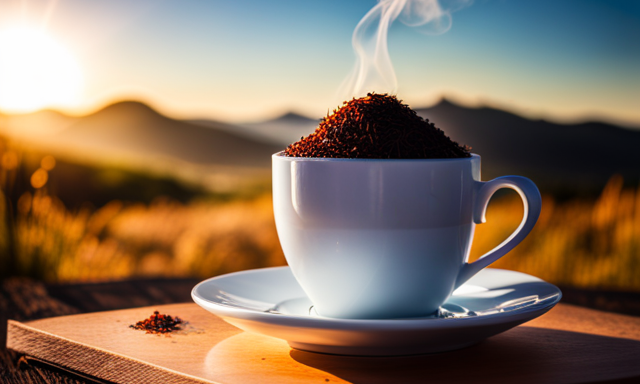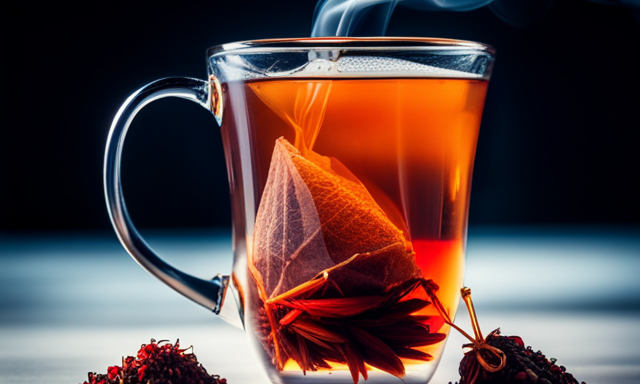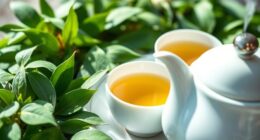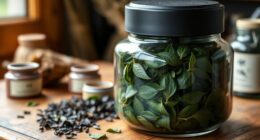I first discovered the wonders of Rooibos tea when I was searching for a healthier alternative to my usual cup of black tea.
Little did I know that this humble plant, native to the Cederberg region of South Africa, would completely captivate my taste buds and revolutionize my tea-drinking experience.
Imagine a warm, soothing beverage that not only satisfies your cravings but also offers a myriad of health benefits. That’s exactly what Rooibos tea provides.
From its origins as a traditional herbal remedy used by the indigenous people of South Africa to its popularity worldwide, this tea has become a staple in many households.
In this article, we will explore the fascinating world of the Rooibos tea plant, from its cultivation methods to its nutritional profile and flavor profile.
We will also delve into the various ways to brew and serve this delightful beverage, as well as its culinary uses.
Join me on this journey as we uncover the secrets and delights of the Rooibos tea plant.
Key Takeaways
- The rooibos tea plant is called Aspalathus linearis.
- The plant thrives in well-drained sandy soil and requires at least six hours of direct sunlight daily.
- The leaves are hand-picked at peak maturity and undergo a fermentation process.
- Fermentation develops the unique flavor and color of rooibos tea, and the leaves are dried after fermentation.
Origins of Rooibos Tea
The origins of rooibos tea can be traced back to the indigenous Khoisan people of South Africa. They’ve been brewing this delicious and healthy beverage for centuries.
Rooibos tea is made from the leaves of the Aspalathus linearis plant, a member of the legume family. This plant is native to the Cederberg region of South Africa, where it grows naturally in the wild.
The Khoisan people discovered the many health benefits of rooibos tea long before the rest of the world caught on. It’s rich in antioxidants, which help to fight off free radicals and protect the body against diseases. Rooibos tea is also caffeine-free, making it a perfect choice for those looking to reduce their caffeine intake. Additionally, it’s believed to have anti-inflammatory properties and can help with digestion.
Now that we understand the origins of rooibos tea, let’s explore how it’s cultivated and harvested.
Cultivation of the Rooibos Tea Plant
When it comes to the cultivation of the Rooibos tea plant, there are several key points to consider. First and foremost, the ideal growing conditions must be met in order to produce the best quality tea. This includes a specific climate, soil type, and altitude.
Secondly, the harvesting and processing methods play a crucial role in the final product. The leaves are carefully hand-picked, then undergo a fermentation process to develop their distinctive flavor and deep red color. These steps are vital to ensure the unique and delicious taste of Rooibos tea that I’m passionate about.
Ideal growing conditions
Optimal conditions for growing the rooibos tea plant involve a combination of specific factors. In greenhouse cultivation, maintaining a controlled environment is crucial for the plant’s growth. The temperature should be around 25-30 degrees Celsius during the day and slightly cooler at night. The plant thrives in well-drained sandy soil with a pH level between 4.5 and 6.5. Soil composition is essential, as it affects the nutrient uptake and overall health of the plant. Adding organic matter and ensuring proper irrigation are vital for optimal growth.
Furthermore, the rooibos tea plant requires at least six hours of direct sunlight daily. These ideal growing conditions provide the plant with the necessary resources to develop its unique flavors and aromas. As the plant thrives under these conditions, it sets the stage for the subsequent section on harvesting and processing methods, where the true essence of rooibos tea is revealed.
Harvesting and processing methods
To bring out the distinct flavors and aromas of your rooibos tea, you’ll want to know the best methods for harvesting and processing. Harvesting techniques play a crucial role in ensuring the quality of the final product.
Rooibos tea plants are carefully hand-picked at their peak maturity, usually during the summer months. The leaves and stems are delicately plucked, taking care not to damage the plant.
Once harvested, the next step is processing. The leaves undergo a fermentation process, where they’re bruised and left to oxidize. This step is essential in developing the unique taste and color of rooibos tea.
After fermentation, the leaves are dried, either in the sun or using specialized drying techniques. This preserves the flavor and aroma of the tea.
Transitioning to the health benefits of rooibos tea, these careful harvesting and processing methods ensure a high-quality product that’s packed with antioxidants and other beneficial compounds.
Health Benefits of Rooibos Tea
Rooibos tea is a remarkable beverage that offers numerous health benefits. Firstly, it’s rich in antioxidants, which help protect our bodies against the damaging effects of free radicals. These antioxidants can boost our immune system, reduce inflammation, and even lower the risk of chronic diseases.
Secondly, drinking rooibos tea has been found to promote heart health by improving blood circulation, reducing cholesterol levels, and preventing the formation of blood clots.
Lastly, this amazing tea supports digestion by soothing the digestive system and relieving common issues like indigestion and stomach cramps.
With its wonderful taste and incredible health benefits, rooibos tea is a true treasure for our overall well-being.
Rich in antioxidants
Indulge in the rich flavors of rooibos tea, a plant that offers you a bounty of antioxidants to enhance your well-being. Rooibos tea is renowned for its antioxidant benefits, which can help protect your cells from damage caused by harmful free radicals.
These powerful antioxidants, such as aspalathin and quercetin, have been linked to numerous health properties, including anti-inflammatory effects and immune system support. Not only does rooibos tea provide a delicious and refreshing beverage option, but it also contributes to your overall health and vitality.
In addition to its antioxidant properties, rooibos tea promotes heart health by lowering blood pressure and reducing the risk of heart disease. With every sip of this delightful tea, you’re nourishing your body and taking a step towards a healthier lifestyle.
Promotes heart health
Boost your heart health and keep your cardiovascular system in tip-top shape by incorporating this antioxidant-rich elixir into your daily routine. Rooibos tea, with its impressive array of antioxidants, is not only a flavorful beverage but also a powerful ally in preventing heart disease and promoting overall cardiovascular health. Its high levels of flavonoids, including quercetin and aspalathin, help to reduce inflammation, lower blood pressure, and improve blood circulation.
By drinking rooibos tea regularly, you can support the health of your heart, reducing the risk of heart disease and maintaining a strong cardiovascular system. Additionally, the antioxidants in rooibos tea protect against oxidative stress, which can damage blood vessels and increase the risk of heart disease. So, make rooibos tea a part of your daily routine and give your heart the love it deserves.
Transitioning into the next section, let’s explore how this amazing tea supports digestion and boosts the immune system.
Supports digestion and immune system
Improve your digestive health and strengthen your immune system by incorporating this remarkable beverage into your daily routine. Rooibos tea not only offers a delicious and refreshing taste, but it also provides numerous benefits for your immune system and digestive health.
Rich in antioxidants, this tea helps to boost your immune system, protecting your body from harmful free radicals and reducing the risk of infections. Additionally, rooibos tea contains natural enzymes that aid in digestion, promoting a healthy gut and preventing digestive issues such as bloating and constipation.
By regularly consuming this tea, you can support your immune system and maintain a healthy digestive system.
Transitioning into the next section, let’s explore the nutritional profile of rooibos tea and discover its many health benefits.
Nutritional Profile of Rooibos Tea
When it comes to the nutritional profile of Rooibos tea, there are two key points that I find particularly fascinating. First, this herbal tea is packed with essential vitamins and minerals that can contribute to your overall health and well-being. From iron and potassium to calcium and magnesium, Rooibos tea is a powerhouse of nutrients.
Second, what sets Rooibos tea apart from other teas is its zero caffeine content. This means that you can enjoy a cup of Rooibos tea anytime, even before bed, without worrying about it affecting your sleep. Additionally, Rooibos tea has a low tannin content, which makes it a gentle and soothing drink for those with sensitive stomachs.
Vitamins and minerals
To get the most out of rooibos tea, you can enjoy its naturally occurring vitamins and minerals, which can help support your overall well-being without any added sugar or caffeine. Rooibos tea is packed with essential vitamins such as vitamin C, which boosts your immune system, and vitamin E, which promotes healthy skin and hair.
It also contains minerals like magnesium, potassium, and calcium, which are important for maintaining strong bones and a healthy heart.
When it comes to the benefits and dosage of rooibos tea, it’s recommended to drink up to 6 cups per day to fully experience its health-promoting effects. However, it’s important to note that excessive consumption may lead to certain side effects such as liver problems or allergic reactions in some individuals. Therefore, it’s always advisable to consult with a healthcare professional before making any changes to your diet.
Moving on to the next section about zero caffeine and low tannin content…
Zero caffeine and low tannin content
Indulge in the guilt-free pleasure of sipping on this soothing beverage, knowing that it won’t keep you up at night or leave you feeling jittery. Rooibos tea is a caffeine-free alternative to traditional teas, making it a perfect choice for those who are sensitive to caffeine or looking to reduce their intake.
Despite its lack of caffeine, rooibos tea is packed with health benefits. It’s rich in antioxidants, which help protect the body against free radicals and oxidative stress. Additionally, it contains minerals such as calcium, magnesium, and potassium, which contribute to overall health and well-being.
With its zero caffeine and low tannin content, rooibos tea is a refreshing and healthy choice. Now, let’s explore the captivating flavor and aroma of rooibos tea.
Flavor and Aroma of Rooibos Tea
Rooibos tea is a delightful beverage with a naturally sweet and nutty taste that I absolutely love. The flavor is unique and distinct, making it a favorite choice for tea enthusiasts like myself.
Additionally, the aroma of rooibos tea is simply intoxicating, filling the air with its warm and inviting scent. It’s like a comforting hug in a cup, and it never fails to uplift my spirits.
Naturally sweet and nutty taste
You’ll love the naturally sweet and nutty taste of rooibos tea, which is why it’s become increasingly popular. Sales have increased by 20% in the past year alone. When you take a sip of rooibos tea, it’s like indulging in a delicious treat.
Here are three reasons why the taste of rooibos tea is so appealing:
- Imagine the smooth, velvety texture of caramel melting on your tongue.
- Picture the warm, comforting flavor of toasted almonds, adding a hint of richness to every sip.
- Experience the subtle sweetness of honey, delicately balancing the earthy notes of the tea.
Rooibos tea’s unique taste sets it apart from other herbal teas. Unlike some herbal teas that can have a bitter or medicinal aftertaste, rooibos tea is naturally sweet and inviting.
As we delve into the aromatic qualities of rooibos tea, you’ll discover how its enticing scent complements its exquisite taste.
Aromatic qualities
Immerse yourself in the captivating aroma that lingers in the air, enticing your senses with its alluring and comforting notes. The aromatic properties of rooibos tea are truly exquisite.
As you brew this delightful beverage, the fragrance fills the room, creating a soothing and inviting atmosphere. The earthy and sweet undertones blend harmoniously, offering a truly unique experience.
To fully appreciate the aromatic qualities of rooibos tea, it’s important to use the proper brewing techniques. Steeping the leaves in freshly boiled water for about 5-7 minutes allows the flavors to fully develop. The result is a warm and comforting cup of tea that’s both aromatic and delicious.
Transitioning into the next section about the types and varieties of rooibos tea, you’ll discover the diverse range of flavors that this remarkable plant has to offer.
Types and Varieties of Rooibos Tea
What are the different types and varieties of rooibos tea?
Rooibos tea comes in various forms, each offering unique flavors and benefits. There are two main types: green rooibos and red rooibos.
Green rooibos is unfermented and has a lighter taste, while red rooibos is fermented and known for its rich flavor. Within these types, there are also different varieties such as honeybush rooibos and vanilla rooibos. These variations add a delightful twist to the classic rooibos taste.
Rooibos tea benefits include its high antioxidant content, which supports overall health and may reduce the risk of chronic diseases. Additionally, rooibos tea blends well with other ingredients like fruits, herbs, and spices, creating endless possibilities for flavorful combinations.
Now, let’s dive into the art of brewing and serving rooibos tea.
Brewing and Serving Rooibos Tea
Now that we know about the different types and varieties of Rooibos tea, let’s delve into the art of brewing and serving this delightful beverage. Brewing Rooibos tea is a simple yet important process that requires attention to detail. To bring out the best flavors, it’s recommended to steep the tea leaves in freshly boiled water for about 5-7 minutes. This allows the natural sweetness and earthy notes to infuse into the water, resulting in a rich and aromatic cup of tea.
As for serving, Rooibos tea can be enjoyed both hot and cold. For a warm, comforting experience, I love to sip on a steaming cup of Rooibos tea with a touch of honey. On the other hand, a refreshing glass of iced Rooibos tea with a slice of lemon is perfect for hot summer days.
Transitioning into the next section, let’s explore the culinary uses of Rooibos tea.
Rooibos Tea in Culinary Uses
To incorporate the unique flavors of Rooibos into your culinary creations, you can infuse the warm, earthy notes of this versatile beverage into a variety of dishes.
Rooibos tea can be used in a multitude of culinary applications, adding depth and complexity to both sweet and savory recipes. Here are three ways you can explore the alternative uses of Rooibos in your kitchen:
-
Create a marinade by steeping Rooibos tea with herbs and spices, then use it to tenderize and flavor meat or tofu.
-
Add a Rooibos infusion to your baked goods, such as cookies or cakes, for a subtle yet distinctive twist on traditional flavors.
-
Use Rooibos as a base for a refreshing sorbet or ice cream, infusing it with fruits and herbs for a delightful dessert experience.
By incorporating Rooibos tea into your culinary repertoire, you can elevate your dishes with its unique taste and bring a touch of South African charm to your table.
Now let’s explore sustainability and fair trade practices in the Rooibos tea industry.
Sustainability and Fair Trade Practices
Through a story of a bustling marketplace where farmers and consumers join hands in a harmonious dance, the tale of sustainability and fair trade practices in the Rooibos industry unfolds.
The Rooibos tea plant, also known as Aspalathus linearis, is cultivated using sustainable farming practices. Farmers employ methods that minimize environmental impact, such as organic fertilizers and natural pest control.
In addition, ethical sourcing is a fundamental principle in the Rooibos industry. Farmers ensure fair wages and safe working conditions for their employees, empowering local communities and promoting social justice.
By embracing sustainable farming and ethical sourcing, the Rooibos industry not only protects the natural resources but also supports the livelihoods of those involved in its production.
Transitioning to the subsequent section about ‘conclusion and recommendations’, it becomes evident that the Rooibos industry serves as a model for other agricultural sectors to embrace sustainable practices and fair trade principles.
Conclusion and Recommendations
In conclusion, it’s clear that the Rooibos industry sets a powerful example for other agricultural sectors to adopt sustainable practices and fair trade principles. The commitment to fair trade practices ensures that farmers are paid fair wages and work in safe conditions, promoting social justice and economic empowerment.
Additionally, the industry’s focus on sustainability is commendable. Rooibos tea is grown without the need for synthetic pesticides or fertilizers, reducing the environmental impact and promoting biodiversity. The cultivation of Rooibos also helps to conserve water, as the plant is drought-tolerant and requires less irrigation compared to other crops.
Furthermore, by supporting the Rooibos industry and consuming products that are sustainably produced and ethically sourced, consumers can contribute to a more equitable and environmentally conscious world.
Frequently Asked Questions
How does rooibos tea compare to other types of herbal teas in terms of health benefits?
Oh, let’s talk about the health benefits of rooibos tea compared to other herbal teas! When it comes to skin health, rooibos tea is a superstar, giving green tea a serious run for its money. It’s packed with antioxidants that can help improve the appearance of your skin, making it look radiant and youthful. So, if you’re looking to boost your skin’s health, rooibos tea is definitely worth a sip!
What is the caffeine content of rooibos tea?
Rooibos tea is naturally caffeine-free, making it a great choice for those looking to reduce their caffeine intake. It offers a wide range of health benefits without the potential negative effects of caffeine. Plus, there are decaffeinated options available for those who still want to enjoy the taste.
Are there any potential side effects or risks associated with drinking rooibos tea?
There are no known potential side effects or risks associated with drinking rooibos tea. It is a safe and healthy beverage that can be enjoyed without any concerns.
Can rooibos tea be consumed by pregnant or breastfeeding women?
Rooibos tea is safe for pregnant and breastfeeding women. It’s caffeine-free and packed with antioxidants, vitamins, and minerals that can benefit both mom and baby. Enjoy a cup of this delicious and nutritious tea without worry!
Is there a difference in the flavor and aroma of different varieties of rooibos tea?
There is indeed a noticeable difference in taste and aroma among various varieties of rooibos tea. Factors like the cultivation region, processing techniques, and blending can greatly influence the flavors and scents. Exploring different rooibos tea preparation methods can enhance the experience even further.
Conclusion
In conclusion, I must say that Rooibos tea is truly a remarkable beverage. Its origins in South Africa and the meticulous cultivation process make it a unique and special plant.
Not only does Rooibos tea offer a range of health benefits and a rich nutritional profile, but its distinct flavor and aroma make it a delight to drink.
Despite any skepticism, I assure you that once you try Rooibos tea, you’ll be hooked. So go ahead, brew yourself a cup and indulge in the wonders of this exquisite tea.


